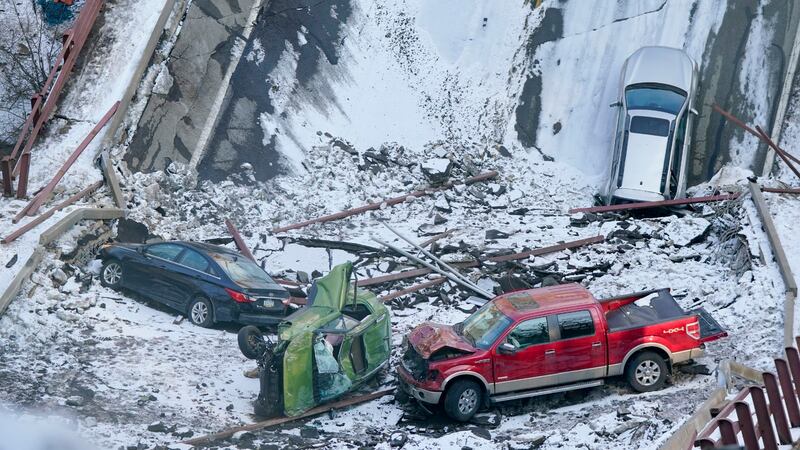PITTSBURGH — The National Transportation Safety Board (NTSB) on Monday released their preliminary report on the Fern Hollow Bridge Collapse that happened on Jan. 28 in Pittsburgh.
The report indicates that the collapse started on the west side (Squirrel Hill) of the bridge.
NEW PHOTOS: A look at the bridge collapse through the eyes of the first responders
The following is what the NTSB released:
What Happened
This is preliminary information, subject to change, and may contain errors. Any errors in this report will be corrected when the final report has been completed.
Release Date: February 7, 2022
On Friday, January 28, 2022, about 6:40 a.m. eastern standard time, the Fern Hollow bridge, which carried Forbes Avenue over the north side of Frick Park, in Pittsburgh, Allegheny County, Pennsylvania, experienced a structural failure. As a result, the 447-foot-long bridge fell approximately 100 feet into the park below. At the time of the collapse, a 2013 New Flyer articulated bus, operated by the Port Authority of Allegheny County, and four passenger vehicles were on the bridge. A fifth passenger vehicle drove off the east bridge abutment following the collapse and came to rest on its roof on the exposed ground below. As a result, 10 vehicle occupants sustained injuries.
RELATED: Target 11: Fern Hollow Bridge warning signs were there going back a decade
In the area of the collapse, Forbes Avenue is a four-lane, non-divided roadway consisting of two travel lanes each in the eastbound and westbound directions. Sidewalks flanked the travel lanes on both sides. The posted speed limit on the bridge was 35 mph. The posted weight limit on the bridge was 26 tons. At the time of the collapse, it was snowing, and some snow had accumulated on the roadway and bridge surfaces.
The bridge was an uncoated weathering steel, three-span, continuous rigid “K” frame structure with two welded steel girders, welded steel floor beams, and rolled steel stringers. [1] The ends of the structure rested on reinforced concrete caps on stone masonry abutments. Each girder was additionally supported by two inclined, welded steel frame legs, also made of uncoated weathering steel, which rested atop reinforced concrete thrust blocks. Although certain areas of the welded steel girders were identified as being fracture critical, no primary fractures were found in these areas. [2]
The collapsed Fern Hollow bridge, as viewed from the east approach, showing the transit bus and four of the five passenger vehicles.
Initial assessment of bridge components indicates that the collapse initiated at the west end of the structure. Further examination will be performed as debris from the bridge is removed and unobstructed access becomes available.
PHOTOS: Crews lift PAT bus hundreds of feet in the air after Pittsburgh bridge collapse
The Port Authority bus was traveling eastbound at the time of collapse. The bus was equipped with seven cameras: one forward-facing camera, one right side aft facing camera, and five interior cameras. Video data from these cameras have been recovered, and the initial assessment of the video data is consistent with the initial assessment of the bridge components. The National Transportation Safety Board (NTSB) will convene a group of specialists to analyze the video for further information useful to the investigation.
Assisting the NTSB investigation are the following parties:
- The Federal Highway Administration
- The Pennsylvania Department of Transportation
- The City of Pittsburgh, Pennsylvania
- The Port Authority of Allegheny County, Pennsylvania
The NTSB is evaluating the design of the bridge, its condition at the time of the collapse, its maintenance and rehabilitation history, and its inspection and load rating history. As the investigation progresses, the NTSB plans to conduct forensic examination of several of the bridge’s structural components. The recovery of evidence, including extraction and documentation, is expected to be a lengthy process. All aspects of the collapse remain under investigation while the NTSB determines the probable cause, with the intent of issuing safety recommendations to prevent similar events.
SPECIAL SECTION: Everything related to the Fern Hollow Bridge Collapse
[1] Uncoated weathering steel refers to a group of steel alloys that are designed to, over time and with exposure to weather, form a protective patina that negates the need for painting.
[2] Per 23 Code of Federal Regulations 650.305, a fracture critical member is a “steel member in tension, or with a tension element, whose failure would probably cause a portion of or the entire bridge to collapse.”
TRENDING NOW:
©2022 Cox Media Group






